Archive for November, 2008
It’s funny how you plan things, and then you somehow get taken in a completely different direction. I had thought to spend quite a bit of time practicing and playing with loop, coil, boucle etc. yarns, but then I bought a pair of fine cloth carders at P&M and suddenly I just wanted to blend everything in sight!
We did do a bit of fancy plying - some curly Wensleydale and knot yarns, I’m not sure what happened to the samples though. Maybe they’re under the sofa at Sarah’s still… In any case, we still had a lot of fun, and looking over the samples, we did do quite a bit - I hope you find them interesting!
Some of these are mine, and some are Sarah’s. She tied hers neatly into butterflies so it’s easy to tell the difference. We spun and plied them mostly on spindles, it’s definitely my favourite way of producing a bunch of samples in a short time.
Merino colour blends:

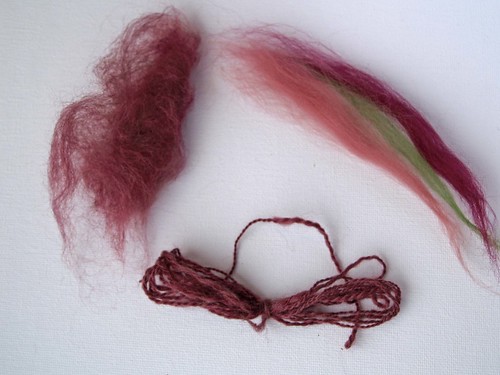

We were working on an idea here about achieving depth of colour with the blends. Abby’s tutorial on tweed yarns a while back got me thinking about the effects you get when you combine various colours. We followed a kind-of formula here by mixing complementary colours and then adding a teeny bit of a contrast for added depth.
Merino/Mohair blend:
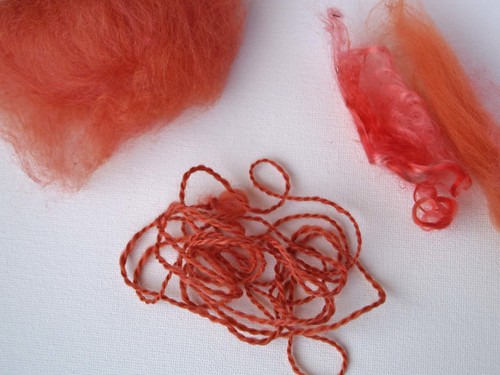
This is about 50/50 I think, although I didn’t measure it really. Once again, the difference in the colours adds depth to a yarn that a solid-dyed colour doesn’t have.
Mohair/Silk blend:

This is the same mohair blended with some dyed tussah silk, once again, about 50/50. It’s hard to tell from the photo, but the yarn turned out lovely! I’d really like to explore this blend further.
Alpaca/Bamboo (?) blend:
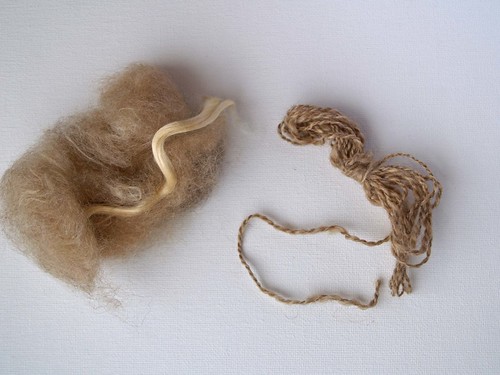
Not quite sure, this was one of Sarah’s. I’ll have to ask her about it. Yummy yarn though.
Combed Wensleydale:

Just for fun, I combed some locks that I had brought with me. It was fairly hard going, and a lot of waste, as the locks were a bit matted. But the resulting prepped fibre was a dream to spin and made a lovely lustrous yarn.
I’ll definitely be doing this again, maybe I’ll have a sampling party at my house one day :-)
 5 Comments » 5 Comments »
This has been on my wheel:

BFL Halo from The Natural Dye Studio, in Candyfloss. Have I ever mentioned that I LOVE this fibre?? It’s squidgy and fluffy and puffs up like you wouldn’t believe when you wind it off the bobbin. This is part of a Very Secret Project, but I’ll be able to show you soon.
More pink:

Alice hosted a swap night at Socktopus on Tuesday and I was lucky enough to grab me a skein of Koigu. It was the only thing I swapped, but it doesn’t take much to make me happy (koigu will do that) so I came home very satisfied.
And since pink seems to be the theme around here, I will mention that yesterday while I was spinning I realised that the sweater that I was wearing (it has been seriously sweater weather here) almost exactly matched the yarn I was spinning. I seem to have definitely made it beyond blue.
But just to prove that all is not lost, this is what I’m about to cast on. Yep, blue.

Have a great weekend, I’m off to Norfolk for the Socktopus Lucy Neatby Retreat - I’m so excited! There will be a Spin-In, but I will post it late Sunday night or early on Monday, depending on when I get back. (ETA: in a stroke of genius, I have figured out how to post-date a blog entry. All being well, the Spin-In will appear at 9am on Sunday).
Ciao!
 No Comments » No Comments »
There are three classes scheduled for the first weekend in December (i.e. Dec 6 and 7). Would love to see you there!
Sat 11-2: Single Spun
Spinning soft, fat singles to create a stripey yarn effect. Class fee includes 100g hand-dyed fibre for your project. This is the yarn I used in my Morning Surf Scarf.
Sun 10-1: Stunning Silk
Tussah, Bombyx, silk blends, cocoons… a whole morning of exploring this fabulous fibre.
Sun 2-5: Mohair Madness
everything you never knew you could do with mohair. Preparing, blending, spinning and a load of chatter about where it comes from and what you can do with your yarn.
10% discount if you attend two or more classes. All classes are held at the new Socktopus shop, click here to book online.
 1 Comment » 1 Comment »
Today I’m up in Leicester with Yoshimi, and I came armed with piles of different fibres, and these:
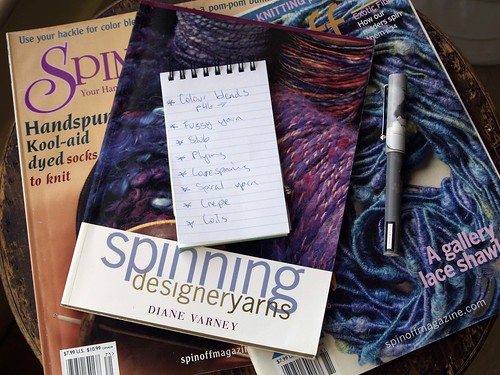
We’re planning to work our way through Diane Varney’s book, which contains loads of interesting stuff. I hesitate to say ‘novelty yarns’ because I don’t want to conjure up visions of fun fur and sparkly acrylic. Rather, think loop yarns, core-spinning, boucle, beads, (on-purpose) slub effects and blending. I’m bringing along the Spin-Off too as I’ve wanted to try that wrap-and-roll yarn for ages.
I’m not sure how many we’ll achieve, but I do know it’s going to be a lot of fun! Maybe the yarns will become more interesting as the beer and pringles run out…
So what are you spinning today? Have you ever spun (or wanted to spin) a novelty yarn? Why not spend ten minutes today sampling something you’ve never tried before :-)
I’m getting a train back tonight, but not sure what time, so you might see me on Lingr if I get in early enough. If not, feel free to talk amongst yourselves!
Ciao!
 3 Comments » 3 Comments »
I believe I have solved my nothing-to-spin situation, well, temporarily at least.
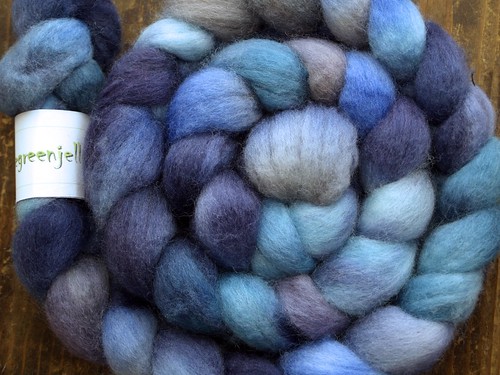
This one is from Lime Green Jelly. It’s got green bits too which didn’t show for some reason, the light’s odd today.
And I wonder what this could become?
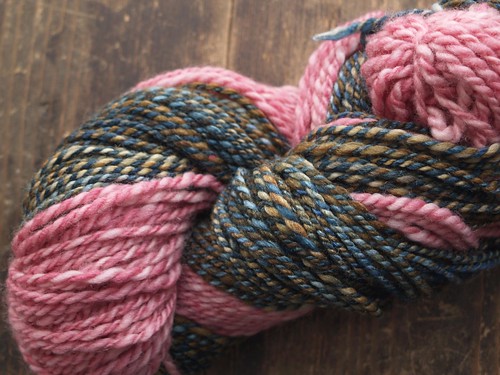
For a special someone perhaps…
 8 Comments » 8 Comments »
 Posted by: Diane in Spin-In
Posted by: Diane in Spin-In
I’m dashing out the door in twenty minutes, so for today’s Spin-In I’m recycling my answer to a question I asked earlier in the week. Hope you don’t mind!
Q: Why is my skein underplied now, when before I washed it it looked balanced, or maybe a little z-twisty?
Plied yarns can be considered underplied, balanced, or overplied. In a balanced yarn there is a complementary amount of twist to that which was put into the singles, the plied yarn hangs in an open loop. Underplied yarn has less plying twist than spinning twist, and will hang with an s-twist (twists up like the letter s), overplied yarn will hang with a z-twist. There may be cases where you might want any one of these three - e.g. extra plying twist will help your yarn bounce and poof up, great for a woolly hat, but not what you want in a lace yarn though!
If you are plying your yarn fresh off from spinning it, you can check whether you are over/under/balanced by pulling some plied yarn off the wheel or spindle and letting it relax - does it twist up or hang open? But where you might run into difficulties is if your yarn hung nice and balanced when plied, but after washing was suddenly underplied. This is where we get into the complicated territory of singles that have been left to ‘set’ before plying.
Let’s say we put (a random number) a twist of ‘5’ into our singles when spinning. For a balanced yarn, we want to ply it back also with a twist of 5, or maybe 6 for a bit of bouncy overtwist. But the singles have been sitting on the bobbin for three days and even though they have a twist of 5, they look like they only have a twist of 3 now. If we ply with a twist of three, it will look balanced right up until it’s washed. Then all that twist will come back and our skein is underplied. Think of when you put your hair into braids. If you leave them in long enough, your hair will end up wavy, but this will disappear next time you wash your hair. Similarly with yarn, the original twist will come back when it’s wet - but we can’t wet our singles before we ply them.
You’ll almost always be plying yarn where at least one of the plies has been left to sit for a while, and you need to know what the original twist was. There’s two ways of dealing with it: If you’re of the organised persuasion, break off a length of yarn from your freshly spun bobbin/spindle and fold it back on itself, letting it twist up. This will show you the balanced twist of that yarn. You can leave that singles sit for a month if you like, just don’t lose the sample and you will know what your plied yarn needs to look like. The second way, for the absent-minded, is to break off that piece of yarn from the ‘set’ bobbin, fold it in half and knot the loose ends, then drop it in water. It will twist up in a very satisfying cool-to-watch way. And you have your balanced twist.
As you’re plying, ignore what the yarn is telling you - it will probably kink up like a maniac - and keep your little sample close by as a gauge. Once you wash the yarn, the twist will all balance out and you should have the correct amount.
Lastly, if you have a washed skein which you’re not happy with, simply wind into a ball and ‘ply’ it again, adding more twist or taking some out with the spindle or wheel until it’s where you want it. You can do this with any yarn that has too much or too little twist. You can even undo it completely and wind it back into singles - if you really wanted to…
—–
I’m out teaching today, and eating cake at Alice’s (yum!) but I’ll be back for Lingr between 6pm and 10pm tonight. Hope to see you there!
P.S. I haven’t forgotten the prize draw! The random-number-generator-hat just popped out two people for me, congratulations Carie and SylvChezPlum! I’ll email you tonight, or drop me a line if you see this :-D
 3 Comments » 3 Comments »
I have been going through the wips at a great rate lately. This is not an unusual phenomenon, I have read other blogs where knitters finish up piles of things all at once. With me, I think it’s a result of getting to a point where I think ‘Oh crap! There’s a lot of stuff littering the place! And my naturally tidy and ordered mind (I heard you snigger, it’s going to thunderstorm from a little cloud over your head today because of that) wants to trim down the pile to something more rational.
So I have two more FOs (which I won’t show you today because they are both in serious need of blocking first), and with the wip list getting shorter, I’ve dug out an old friend which was snoozing at the bottom of the workbag.
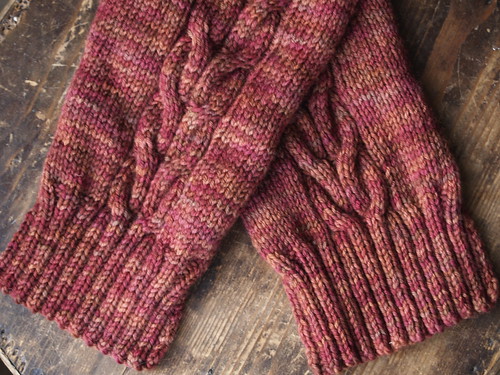
These are the sleeves for my Central Park Hoodie, I am a few inches into the back. I was knitting this last winter and, as is my experience with most winter knitting, the weather got warm when I was halfway through and it was abandoned. Well, I’ve had many days so far this last few weeks when I wanted to wear it, so out it comes!
In other news, I plied up my first teeny skeins of cotton spun on the charkha:
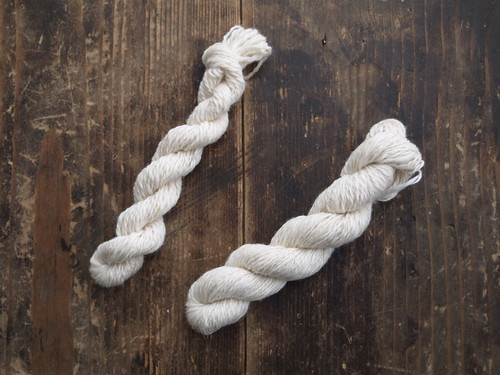
I am quite disproportionately proud of this achievement :-D the smaller skein is the first spindle-full plied on itself, the larger skein is the second and third spindles plied together. It looks pretty even (and in fact is) but I will admit that the evenness was a result of severe micro-management of the singles - as in, I twiddled out every little bump that I made while I was spinning. Yesterday though, something finally clicked and I’ve pretty much got it down. I’m only getting a bump I want to fix in maybe every fourth or fifth length spun.
And finally, I was looking through my stash the other day, and discovered that there was Nothing To Spin! Luckily, this was on its way to me!

Hand-dyed Falkland tops from Spindlefrog. They are gorgeous and I just might spin one today :-D
 8 Comments » 8 Comments »
Yep, three, no less :-) I’ve been industrious.
First up, which you saw a bit of last week, is the MIL Swallowtail:
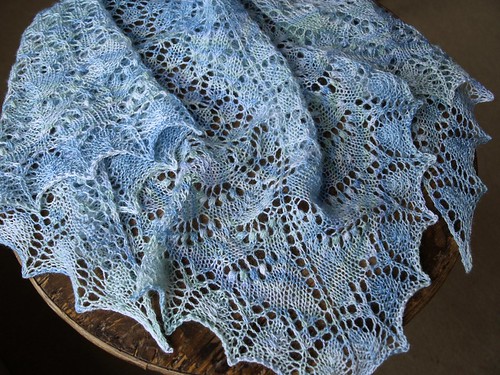
This is my second Swallowtail and definitely won’t be the last. It’s knitted from Live2Knit Marlene yarn, a merino/silk laceweight. I used a 3.5mm needle and didn’t do any extra pattern repeats - although I could have, I had 20g left over from the 50g skein.
On Saturday I got a bit tired of all the spinning (still on the gold spider hair) and I whipped up a quickie scarf. A long long time ago, I bought this yarn and thought I’d maybe do something with it, a slightly less long time ago Kate knitted me a hat. There was still loads left over and when I started weaving this year it occurred to me that it might work well in a woven scarf.
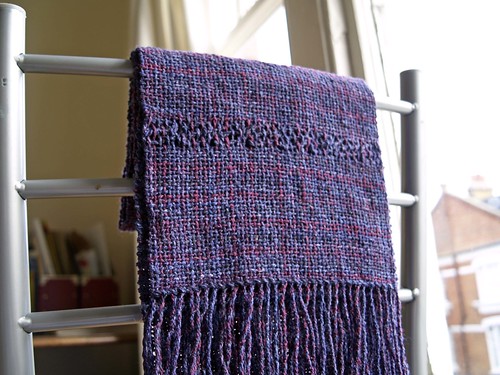
It did! I’m hoping it will bloom a little more when finished, I haven’t been able to wash it yet as there’s nowhere atm to get it dry. It was also my first attempt at a pattern (other than stripes). The motif is called ‘Spanish Lace’ and I found it in this article in Weavezine. If you’re a weaver, or thinking about becoming one, definitely check out this magazine - it’s fab!
Finally, I cast off last night on the Hopscotch Socks, the fifth instalment from this year’s Sock(topus) Club. It was a fun pattern and I finished just in time to receive the last parcel - hopefully out next week!
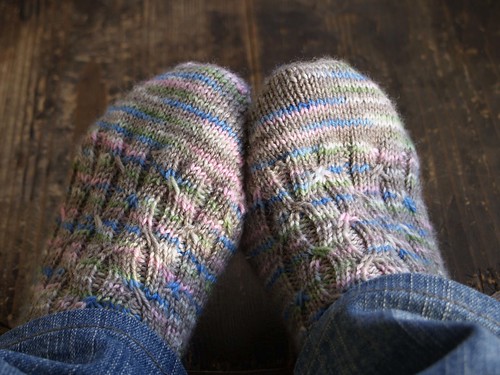
The yarn is from Brooklyn Handspun and was great to knit with. I might have to have a prod of the other colours when I visit Alice at the shop later today!
 5 Comments » 5 Comments »
 Posted by: Diane in Spin-In
Posted by: Diane in Spin-In
There are two widely used methods for measuring spun yarn. One, the yards per pound measurement, is usually taken using a piece of equipment called a McMorran Balance. There’s a good article in the Summer 08 Spin-Off explaining this. A McMorran measurement, however, won’t really tell you how thick your yarn is - a heavy, drapey fingering weight may come up at the same ypp (yards per pound) as a light poofy DK, as the yarns each have the same amount of fibres, just spun in a very different way. Measuring the wraps per inch (wpi) will tell you the exact grist (thickness) of your yarn, although it won’t describe the density for you. Combining both measurements will give you the most complete picture.
Firstly, why would we even measure wraps per inch? Well, a few reasons. Taking notes of measurments such as grist, ratios spun and so on, gives you valuable information should you want to recreate the yarn at a later date. It may be that you want someone else to be able to recreate the yarn - e.g. in a published pattern. The more information you have, the better.
Measuring the wpi is also a good way to check a substitute yarn. Commercial yarns give a gauge on the ball band, but rather than knit swatches with all your handspun to find a match, you can simply measure the wpi of the commercial yarn, and those of your handspun skeins. Knowing the wpi can also give you a starting point for needle size - there’s a handy table in this article listing wpi and equivalent gauge.
So how is it done? Measuring wpi is quite simple really, however there are variables in play and it’s a good idea to practice a bit to make sure you are consistent. Instructions such as ‘wrap evenly and not too tightly’ are actually quite subjective, you may wrap ‘not too tightly’ with different judgement to someone else. If you know that you are always consistent yourself, then that is a good starting point.
Specially made wpi tools like this one are handy, but not essential. You can wrap your yarn around anything with measurements marked on it - or even a piece of dowel with tape markers. Wrap slowly and evenly, placing each layer next to the last without squashing them. This is much easier with smooth, drapey yarn than soft and puffy!
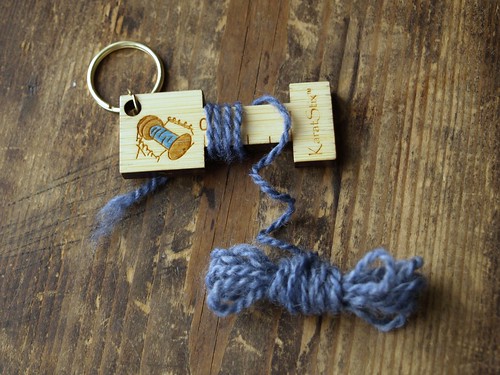
Continue until your inch is full - don’t be tempted to stop at half an inch as your reading may be inaccurate. Check that the yarn is not too tight or too loose, the threads should be touching, but not squashed. This yarn measures 12 wpi.
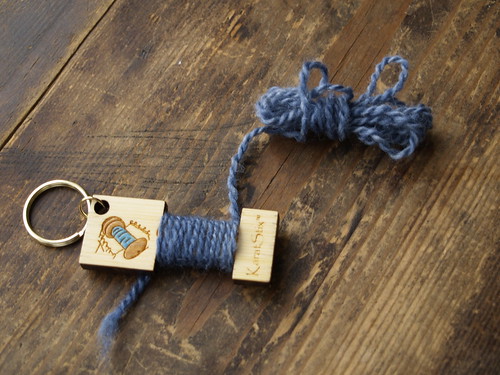
And that’s all there is to it! Practice measuring your yarn - find some commercial yarn you think looks the same as your handspun then measure them both to see how close you were. Measure different parts of your skein to check whether it’s even. Measure everything in sight until someone gets tired of you and takes away your ruler :-)

I have two little wpi tools to give away this week - leave me a comment telling me what you’re spinning today and on Thursday morning I’ll draw some names out of the proverbial hat. Good luck!
Don’t forget, we’re now on Lingr. Pop by today for a chat :-)

 31 Comments » 31 Comments »
 Posted by: Diane in General
Posted by: Diane in General
I’m not going to keep Christmas knitting/spinning secret and invisible - there wouldn’t be much left to put on my blog this year if I did! I’m just not going to tell anyone who things are for :-D Some things are going in a big pile and don’t have a name on yet, so if you think you might be on my gift list and you see something you love, wave your hands in the air.
This, however, has a destination planned. In fact, the skein of yarn has had a mental label on it for more than a year. Finally I have got around to starting.
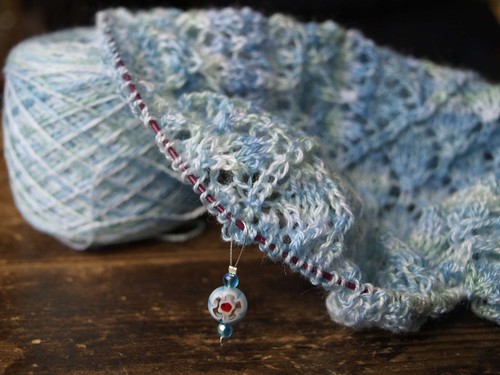
As is the way with all lace, it looks pretty boring at the moment, so you should just admire instead the gorgeous stitch marker, from a set of four that Jen gave me on the weekend. The shawl will grow up to be a swallowtail, and I’ve just finished the bud lace section. A couple more days should have it done, and I’ll be launching into the task of spinning up several skeins of lace-weight for… some people dear to my heart :-)
 6 Comments » 6 Comments »
|


























 Entries (RSS)
Entries (RSS)